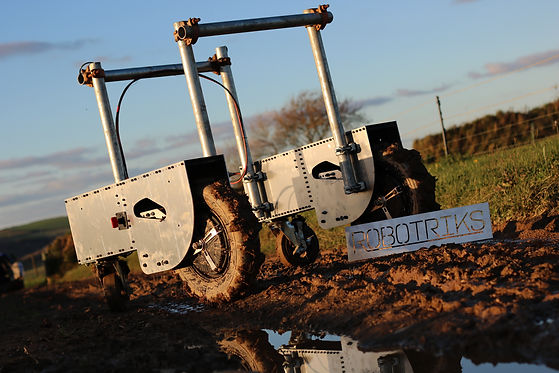
Introducing:
THE RTU
(The Robotriks Traction Unit)
Scroll Down

Robotriks Ltd received funding from the Agritech Cornwall Innovation Grant Scheme funded from the ERDF as part of the European Structural and Investment Funds Growth Programme 2014-2021. The funding has helped pay towards an RD&I in the field of agricultural robotics. Further details of the project can be found below.

What is the RTU?
The RTU was designed from the ground up to be a low-cost, modular platform to facilitate autonomous robotics in a farm environment.
With its range of sensors and high power motors, it is able to compute all of the data it collects on-board, without a need for a network connection. From automating soil sampling, to localised pesticide delivery or even crop monitoring and harvesting, the RTU is the platform that can make this an affordable possibility.


Features:
- 2x High power brushless motors
- Built in battery with quick release
- RTK2 Global Positioning with 11mm accuracy
- Top and bottom T-slot channel mounting
- Adjustable frame height and width
- Teleoperation wireless controller
- Intel core i7 and External PCIe 16x slot supporting GPUs up to 250W*
*When compute package selected

The RTU V1
The design that took power and simplicity to heart. This 40mph platform showed what was possible at a low cost.

The RTU V2
Refined and improved. Using field trials as feedback, the v2 slows down the pace and improves traction with its integrated suspension.

'Smart' Agriculture
The idea of a low cost, autonomous, agricultural platform originally came from a mix of inspirations.
Firstly, having grown up in farming environments, we were very aware of the issues faced everyday by both farmers, and researchers when they want to analyse their crops or fields. Tractors are expensive, large and heavy vehicles that compact the soil and can easily damage fields and crops. They are fantastic when raw power is required, however they aren't ideal for more delicate operations.
This is where manual labour would usually come in. However, finding the people willing to do these roles is increasingly difficult. It seems more people would rather spend time online than out doing the dirty work.
Secondly, electric bikes have become a far more common method of transport, and with that, the brushless hub motors that power them have become far more abundant. Motors that fit inside of the wheels, that can reach 60mph+ whilst having over 100NM of torque for the fraction of the weight of a petrol or diesel engine.
So what would happen if you cross over the technology?
That is what we began to explore, and that is how the RTU took shape.
Design Considerations
Soil Compaction - The RTU weighs less than 100kg and features tyres that are 4 inchs wide. This results in a soil compression similar to a human.
Navigation - By combining all 4 of the widely available satellite navigation systems; GPS (US), GLONASS (Russia), Galileo (EU), BeiDou (China), the RTU can be tracked in all 3 dimensions with centimetre grade accuracy.
Crop Widths - Is an aspect that can vary per crop and per field. This is why the connecting truss that holds together the RTU is adjustable. You can easily adjust the frame vertically or horizontally to make it suit your needs
Hardware Mounting - The RTU isn't just a platform to ride around on, it has been designed to have a huge range of attachments so that different tasks can be fulfilled. You can mount to the drive units t-slots, the truss or the side panels.
What can it be used for?
We are still hard at work developing and improving the RTU, however there are a number of tasks that we have already begun testing. These challenges were chosen as there is a real world need for solutions and the RTU, we believe, is the platform that can make these happen.
These include:
- Autonomous Field Navigation Featuring -
Crop Analysis, Monitoring and Harvesting
Soil Carbon, Moisture and Compaction Data Collection
Grass Cutting
Weed Identification and Eradication




Agritech Cornwall
Prior to this project, we had never designed a rover that was intended for outdoor use like this. Designing a platform that can handle the outdoors, in all weathers, with thick mud wanting to clog every possible gap, can be quite the challenge. However, thanks to this undertaking, our experience and capabilities have expanded greatly. We built the first prototype, tested it out in the field, and then continued to improve it. This development will continue. However, the RTU project would not have been possible without the support from Agritech Cornwall.
Such an autonomous robotic platform, capable of patrolling farm rows, bridging crops and collecting data regarding so many aspects of the field, would have cost tens to hundreds of thousands of pounds and required large bulky equipment, usually bolted on to a tractor. In this regard, the RTU is a brand new approach to the market. A new way of solving the issues out in the field. A lightweight autonomous vehicle that protects the soil, whilst managing to collect thousands of data points to help the farmer make their decisions and manage their land.
Best of all, not only was it designed, developed and tested in Cornwall, but it is built in Cornwall. Proper Job!


This project would not have been possible without the fantastic team involved with Agritech Cornwall. What started out as a crazy idea, turned into a physical prototype. Then under rapid iteration, the market potential began to expand. There are so many problems this platform can solve, and we are only just starting to scratch the surface.
Jake Gibson Shaw-Sutton / Director / Robotriks Ltd
















